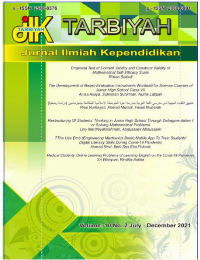Restructuring Of Students’ Thinking in Junior High School Through Defragmentation for Solving Mathematical Problems
DOI:
https://doi.org/10.18592/tarbiyah.v10i2.4810Abstract
Problem-solving in math is still a problem today. Studies show that students still make mistakes in answering math problems. Errors in answering the questions indicate that there is fragmentation in the thinking structure of students. This article uses a systematic review method. Researchers selected articles according to the criteria and found 9 articles with a total of 25 research subjects. Data collection was carried out in two main stages, namely the search and selection stages. The results show that students experience many obstacles at the stage of re-checking the integrity of the completion steps because of the habit of students who skip the re-examination and are sure that the answer is correct. A common type of error in the construction of a mathematical concept is a construction hole. Construction holes can be overcome by the emergence of schemes to complement the imperfections of students' thinking structures in solving mathematical problems. The type of defragmentation that is most often given is scaffolding. Scaffolding is considered the most effective for all types of mistakes made because it can be done and later reduced so that students can solve math problems independently.References
Abidin, Z. (2014). Proses Metakognisi Mahasiswa Calon Guru dalam Memecahkan Masalah Matematika. Jurnal Riset Pendidikan Matematika, 2(1), 25–40.
Biber, Ç., Tuna, A., & Korkmaz, S. (2013). The Mistakes and the misconceptions of the eighth grade students on the subject of angles. European Journal of Science and Mathematics Education, 1(2), 50–59.
Chairani, Z. (2015). Scaffolding dalam pembelajaran matematika. Math Didactic: Jurnal Pendidikan Matematika, 1(1), 39–44. https://doi.org/10.33654/math.v1i1.93
Dwan, K., Gamble, C., Williamson, P. R., & Kirkham, J. J. (2013). Systematic Review of the Empirical Evidence of Study Publication Bias and Outcome Reporting Bias - An Updated Review. PLoS ONE, 8(7), e66844. https://doi.org/10.1371/journal.pone.0066844
Efendi, J. F., & Pratama, R. A. (2020). Defragmenting Proses Berpikir Pseudo Siswa dalam Menyelesaikan Masalah matematika. AKSIOMA: Jurnal Program Studi Pendidikan Matematika, 9(3), 651–661. https://doi.org/https://doi.org/10.24127/ajpm.v9i3.2956
Gal, H., & Linchevski, L. (2010). To see or not to see: Analyzing difficulties in geometry from the perspective of visual perception. Educational Studies in Mathematics, 74(2), 163–183. https://doi.org/10.1007/s10649-010-9232-y
Gunawati, E., Nusantara, T., & Qohar, A. (2015). Defragmenting Struktur Berpikir Melalui Pemetaan Kognitif Untuk Memperbaiki Kesalahan Siswa dalam menyelesaikan Soal Cerita pada Materi Balok. Sendimat III: Seminar Nasional Pendidikan Matematika Ke-3, 257–265.
Hanifah, A. I. (2018). Defragmenting Perajutan Skema Siswa Smp Dalam Menyelesaikan Masalah Aljabar. Jurnal Reforma, 7(1), 12–18. https://doi.org/10.30736/rfma.v7i1.36
Hidayanto, T., Subanji, & Hidayanto, E. (2017). Deskripsi Kesalahan Struktur Berpikir Siswa SMP Dalam Menyelesaikan Masalah Geometri Serta Defragmentingnya: Suatu Studi Kasus. Jurnal Kajian Pembelajaran Matematika, 1(1), 72–81.
Kirnasari, T. P. (2016). Defragmenting Struktur Berpikir Melalui Pemetaan Kognitif untuk Memperbaiki Kesalahan siswa dalam Memecahkan Masalah Persamaan Kuadrat. Universitas Negeri Malang.
Kumalasari, F., Nusantara, T., & Sa’dijah, C. (2016). Defragmenting struktur berpikir siswa dalam menyelesaikan masalah pertidaksamaan eksponen. Jurnal Pendidikan: Teori, Penelitian, Dan Pengembangan, 1(2), 246–255.
Kurniasih, A. W. (2012). Scaffolding sebagai Alternatif Upaya Meningkatkan Kemampuan Berpikir Kritis Matematika. Kreano, Jurnal Matematika Kreatif-Inovatif, 3(2), 113–124. https://doi.org/10.15294/kreano.v3i2.2871
National Council Of Teachers Of Mathematics. (2000). Principles and Standards for School Mathematics. School Science and Mathematics.
Nazihah, Z. (2018). Defragmening Struktur Berpikir Mahasiswa dalam Mengidentifikasi Homomorfisma Ring. Jurnal Ilmiah Edukasi & Sosial, 9(1), 90–95.
Ribaupierre, A. De. (2015). Piaget’s Theory of Cognitive Development. In International Encyclopedia of the Social & Behavioral Sciences: Second Edition (pp. 120–124). https://doi.org/10.1016/B978-0-08-097086-8.23093-6
Rochayati, M. Y., & Fa’ani, A. M. (2019). Defragmentasi Struktur Berpikir Siswa dalam Menyelesaikan Masalah Analogi. International Conference on Islamic Education: Challenges in Technology and Literacy, 4, 321–330.
Septian, A. D., Chandra, T. D., & Dwiyana. (2018). Defragmentasi Struktur Berpikir Siswa Impulsif dalam Menyelesaikan Soal Cerita. Jurnal Pendidikan, 3(8), 994–1011.
Sholekah, L. M., Anggreini, D., & Waluyo, A. (2017). Analisis Kesulitan Siswa Dalam Menyelesaikan Soal Matematika Ditinjau Dari Koneksi Matematis Materi Limit Fungsi. WACANA AKADEMIKA: Majalah Ilmiah Kependidikan, 1(2), 151–163. https://doi.org/10.30738/wa.v1i2.1413
Siregar, N. (2017). Problem Solving Ability Of Students Mathematics In Problem Based Learning. Journal of Educational Science and Technology (EST), 3, 185. https://doi.org/10.26858/est.v3i3.4475
Subanji. (2015). Pengantar teori kesalahan konstruksi. In Teori kesalahan konstruksi konsep dan pemecahan masalah matematika (pp. 1–17). Universitas Negeri Malang.
Subanji, & Nusantara, T. (2013). Karakterisasi kesalahan berpikir siswa dalam mengonstruksi konsep matematika. Jurnal Ilmu Pendidikan, 19(2), 208–217.
Sudbery, J., & Whittaker, A. (2018). Piaget’s theory of cognitive development. In Human Growth and Development (pp. 297–300). https://doi.org/10.4324/9780203730386-15
Triutami, T. W., Purwanto, & Abadyo. (2016). Peningkatan Level Kemampuan Siswa SMP Kategori Prestructural dalam Menyelesaikan Soal Geometri melalui Pemberian Scaffolding. Jurnal Pembelajaran Matematika, 3(2), 180–191.
Usodo, B., Aulia, I. I., Wulandari, A. N., Sutopo, Setiawan, R., Kurniawati, I., & Kuswardi, Y. (2020). Fragmentation of thinking structure and its impact to students’ algebraic concept construction and problem solving. Journal of Physics: Conference Series, 1567(3), 1567 032006. https://doi.org/10.1088/1742-6596/1567/3/032006
Wibawa, K. A., Nusantara, T., Subanji, & Parta, I. N. (2018a). Defragmentation of student’s thinking structures in solving mathematical problems based on CRA framework. IOP Conference Series: Journal of Physics, 012150.
Wibawa, K. A., Nusantara, T., Subanji, S., & Parta, I. N. (2017). Fragmentation of Thinking Structure’s Students to Solving the Problem of Application Definite Integral in Area. International Education Studies. https://doi.org/10.5539/ies.v10n5p48
Wibawa, K. A., Nusantara, T., Subanji, S., & Parta, I. N. (2018b). Defragmentasi Pengaktifan Skema Mahasiswa Untuk Memperbaiki Terjadinya Berpikir Pseudo Dalam Memecahkan Masalah Matematis. Prima: Jurnal Pendidikan Matematika, 2(2), 93–106. https://doi.org/10.31000/prima.v2i2.755
Wibawa, K. A., Subanji, & Chandra, T. D. (2013). Defragmenting Berpikir Pseudo Siswa Dalam Memecahkan Masalah Limit. Seminar Nasional Exchange of Experiences Teacher Quality Improvement Program (TEQIP) 2013, 2, 721–740.
Wijaya, T. T., Zhou, Y., Ware, A., & Hermita, N. (2021). Improving the Creative Thinking Skills of the Next Generation of Mathematics Teachers Using Dynamic Mathematics Software. International Journal of Emerging Technologies in Learning, 16(13). https://doi.org/10.3991/ijet.v16i13.21535
Wulandari, A. N., Usodo, B., Sutopo, Setiawan, R., Kurniawati, I., Kuswardi, Y., & Aulia, I. I. (2020). Fragmentation of thinking structure: Concept construction and problem solving in geometry of junior high school students. Journal of Physics: Conference Series, 1567(3), 1567 032007. https://doi.org/10.1088/1742-6596/1567/3/032007
Downloads
Published
How to Cite
Issue
Section
License
Authors retain copyright and grant the journal right of first publication with the work simultaneously licensed under a Creative Commons Attribution 4.0 International License that allows others to share the work with an acknowledgment of the work's authorship and initial publication in this journal.




